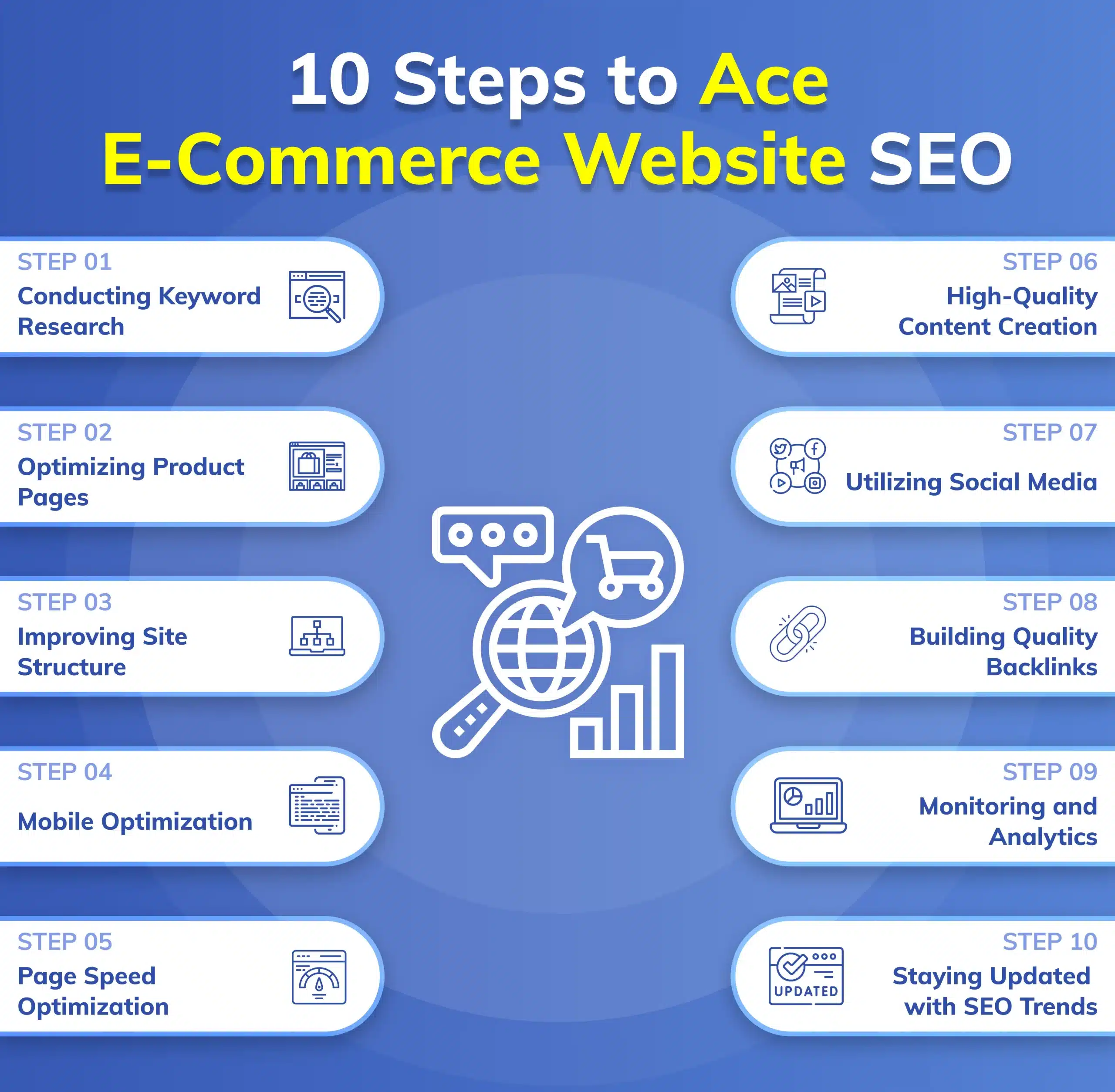Table of content
Are you ready to take your e-commerce website to the next level? Imagine dominating the world of online shopping, driving traffic, and skyrocketing your sales. In this ultimate guide, we will walk you through the crucial steps to achieve just that. So get ready to dive into the exciting realm of E-commerce Website SEO in 2024.
Let’s start by addressing the pain points that many online businesses face today. Are you struggling to attract qualified visitors to your website? Are your competitors outranking you on search engine results pages? Don’t worry, because we have you covered. Our comprehensive guide will equip you with the knowledge and strategies to optimize your website for search engines, ensuring maximum visibility and organic traffic.
Throughout this blog, we will discuss the ten essential steps to dominate E-commerce Website SEO. From conducting effective keyword research to implementing technical optimizations, we leave no stone unturned. By the end, you will have the tools and insights to vault your website to the top of search engine rankings, attracting your target audience and increasing your revenue. Get ready to transform your online business with our expert guidance following these steps.
Step 1: Conducting Keyword Research
Imagine keywords as the compass guiding potential customers to your online store. To begin this crucial step, start by utilizing updated tools at your disposal. Modern SEO demands staying ahead of the curve, and these tools act as your trusted companions in navigating the ever-evolving digital landscape.
As you delve into this research, the goal is twofold: pinpointing high-ranking keywords and ensuring relevance to your products or services. This dual approach ensures that not only do you capture the attention of search engines, but you also resonate with your target audience. In the upcoming sections, we’ll see the intricacies of effective keyword research and equip you with the skills to elevate your e-commerce website SEO in the digital arena.
Step 2: Optimizing Product Pages
Elevate your e-commerce game by focusing on the core of customer interaction – your product pages. Crafting compelling product descriptions is an art that goes beyond listing features; it’s about narrating a story that resonates with your audience. Imagine your product descriptions as the bridge connecting customers to the unique value your offerings bring.
Simultaneously, optimize your product titles with an SEO-friendly touch. Think of these titles as signposts for search engines, guiding them to categorize and showcase your products effectively.
In this step, we’ll explore the nuances of creating descriptions that captivate, inform, and persuade. Additionally, we’ll delve into the science of structuring product titles, ensuring they not only attract the attention of search algorithms but also entice potential buyers to explore further. Mastering this step enhances your online presence and transforms casual visitors into loyal customers.
Step 3: Improving Site Structure
Transform your e-commerce website into a seamless, user-friendly experience by focusing on the crucial step of improving site structure. Picture your website as a digital storefront where effortless navigation is the key to customer satisfaction. Enhancing navigation for user experience ensures that visitors effortlessly find what they seek, reducing bounce rates and maximizing engagement.
Furthermore, creating a logical and organized URL structure is the roadmap for search engines, guiding them through the content landscape of your site. Imagine it as a language search engines understand, making it imperative for effective e-commerce website SEO.
In this step, we’ll explore techniques to refine your site’s architecture, ensuring a smooth user journey and signaling to search engines that your digital space is both user-centric and algorithm-friendly. Elevate your website’s appeal and visibility through strategic structural enhancements.
Step 4: Mobile Optimization
In the mobile-centric landscape of online engagement, optimizing your e-commerce site for mobile is not just a suggestion; it’s a necessity. Consider the significance of responsive design as the cornerstone of this transformation. A responsive design ensures that your website adapts seamlessly to various devices, providing users with a consistent and enjoyable experience, regardless of the screen size.
Now, picture this in the context of mobile-first indexing strategies – an approach where search engines predominantly use the mobile version of your content for indexing and ranking. By aligning with mobile-first principles, you not only cater to the preferences of on-the-go users but also elevate your site’s standing in search engine results.
Step 5: Page Speed Optimization
Recognizing the pivotal role of page speed in your e-commerce website SEO journey is akin to understanding the heartbeat of online success. Picture this: your website’s loading time directly impacts user experience and search engine rankings. Delays in loading can drive potential customers away, impacting your bounce rates and ultimately your bottom line.
Now, envision employing techniques to enhance loading times, creating a seamless digital experience for visitors. Optimize images, leverage browser caching, and compress large files to ensure swift loading. Prioritizing swift loading not only keeps visitors engaged but also signals to search engines that your digital storefront is primed for success in the competitive realm of online retail.
Step 6: High-Quality Content Creation
Imagine your content as the beacon that attracts and retains online visitors. Dive into the world of blogging for SEO, crafting insightful articles that not only showcase your expertise but also resonate with your audience’s search queries. A well-curated blog enhances your website’s relevance, establishing your digital presence as an informative resource.
Now, envision the power of user-generated content. Encourage your audience to share their experiences and opinions. This not only fosters a sense of community but also generates authentic content that search engines value. In this step, we’ll explore the symbiosis of blogging and user-generated content, empowering your e-commerce venture to thrive in the competitive realm of online retail while solidifying your position in the ever-evolving landscape of digital commerce.
Step 7: Utilizing Social Media
Harness the potential of social media to propel your e-commerce website to new heights. Picture social media as a dynamic force that extends beyond engagement – it’s a key player in SEO. Social signals, such as likes, shares, and comments, amplify your online presence, signaling to search engines that your content is valued and relevant.
Now, envision integrating social media seamlessly into your e-commerce strategy. It’s not just about posting; it’s about strategically showcasing your products, fostering community engagement, and leveraging social channels as an extension of your brand. Engage, connect, and watch as your social media presence becomes a driving force behind your website’s visibility and influence in the digital realm.
Step 8: Building Quality Backlinks
Elevate your e-commerce website SEO impact by mastering the art of building quality backlinks. Imagine backlinks as the digital endorsements that vouch for your website’s credibility and authority. Focus on identifying authoritative sources relevant to your industry. Picture these sources as reputable allies whose association adds weight to your online presence.
Now, envision employing natural link-building strategies. It’s not about quantity; it’s about the quality and relevance of the links you cultivate. Through strategic partnerships, content collaborations, and ethical practices, you can organically expand your network of backlinks. By forging authentic connections in the digital realm, your e-commerce venture can solidify its position in the competitive landscape of online retail while optimizing its SEO potential.
Step 9: Monitoring and Analytics
Empower your e-commerce website by embracing the power of data through meticulous monitoring and analytics. Visualize these tools as your digital compass, guiding you through the vast landscape of online performance. Begin by implementing tracking tools that provide valuable insights into user behavior, site traffic, and conversions. These tools act as your watchful eyes, offering a comprehensive view of your website’s health.
Now, picture the significance of analyzing SEO performance data. It’s not just about numbers; it’s about decoding the patterns that shape your online presence. By harnessing the insights derived from these analytics, you gain the knowledge to refine your strategies, optimize user experiences, and steer your e-commerce venture towards sustained success in the dynamic digital landscape.
Step 10: Staying Updated with SEO Trends
Ensure the longevity of your e-commerce success by making the final stride – staying updated with SEO trends. Imagine the digital landscape as a constantly evolving terrain, where strategies that work today may require adjustments tomorrow. Begin by keeping abreast of industry changes. Picture this as a continuous learning journey, staying informed about algorithm updates, emerging technologies, and shifting consumer behaviors.
Now, envision future-proofing your e-commerce website SEO strategy. It’s about anticipating trends, adapting proactively, and ensuring that your digital presence remains resilient in the face of dynamic market shifts. By embracing a forward-thinking approach, you fortify your website against the currents of change and pave the way for sustained success.
Conclusion
In closing, your journey to master e-commerce SEO in 2024 is marked by ten pivotal steps, each a building block for online success. By embracing responsive design, strategic content creation, and staying ahead of evolving SEO trends, you’ve fortified your digital storefront. Picture your website as a dynamic entity, poised to thrive amidst industry shifts. With an optimized structure, compelling content, and a keen eye on analytics, your e-commerce venture is not just visible but influential in the digital landscape. The key lies not only in implementation but in the continuous pursuit of knowledge, ensuring your online presence remains agile and resilient in the ever-evolving realm of digital commerce.









